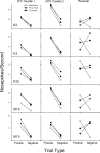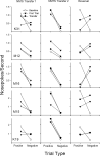Successive odor matching- and non-matching-to-sample in rats: A reversal design
- PMID: 28713029
- PMCID: PMC5767153
- DOI: 10.1016/j.beproc.2017.07.003
Successive odor matching- and non-matching-to-sample in rats: A reversal design
Abstract
There is a growing body of research on matching- and non-matching-to-sample (MTS, NMTS) relations with rats using olfactory stimuli; however, the specific characteristics of this relational control are unclear. In the current study we examine MTS and NMTS in rats with an automated olfactometer using a successive (go, no-go) procedure. Ten rats were trained to either match- or non-match-to-sample with common scents (apple, cinnamon, etc.) as olfactory stimuli. After matching or non-matching training with four odorants, rats were tested for transfer twice with four new odorants on each test. Most rats trained on MTS showed immediate transfer to new stimuli, and most rats trained on NMTS showed full transfer by the second set of new odors. After meeting criterion on the second transfer test, the contingencies were reversed with four new odor stimuli such that subjects trained on matching were shifted to non-matching and vice versa. Following these reversed contingencies, the effects of the original training persisted for many trials with new odorants. These data extend previous studies on same-different concept formation in rats, showing strong generalization requiring few exemplars. The critical role of olfactory stimuli is discussed.
Keywords: Abstract concepts; Identity; Matching-to-sample; Olfaction; Rats; Same-different.
Copyright © 2017 Elsevier B.V. All rights reserved.
Figures




Similar articles
-
Matching- and nonmatching-to-sample concept learning in rats using olfactory stimuli.J Exp Anal Behav. 2011 Sep;96(2):139-54. doi: 10.1901/jeab.2011.96-139. J Exp Anal Behav. 2011. PMID: 21909161 Free PMC article.
-
Generalized identity in a successive matching-to-sample procedure in rats: Effects of number of exemplars and a masking stimulus.J Exp Anal Behav. 2018 Nov;110(3):366-379. doi: 10.1002/jeab.483. J Exp Anal Behav. 2018. PMID: 30431658
-
Effects of set size on identity and oddity abstract-concept learning in rats.Anim Cogn. 2019 Sep;22(5):733-742. doi: 10.1007/s10071-019-01270-5. Epub 2019 May 30. Anim Cogn. 2019. PMID: 31147849
-
Olfactory Generalization in Detector Dogs.Animals (Basel). 2019 Sep 19;9(9):702. doi: 10.3390/ani9090702. Animals (Basel). 2019. PMID: 31546835 Free PMC article. Review.
-
[Influence of training with scents on the perception of pain].MMW Fortschr Med. 2020 Mar;162(Suppl 1):70-72. doi: 10.1007/s15006-020-0301-6. MMW Fortschr Med. 2020. PMID: 32221879 Review. German. No abstract available.
Cited by
-
Generalized, cross-modal, and incrementing non-matching-to-sample in rats.Learn Behav. 2023 Mar;51(1):88-107. doi: 10.3758/s13420-023-00571-7. Epub 2023 Jan 25. Learn Behav. 2023. PMID: 36697934
-
Olfactory Training Prevents Olfactory Dysfunction Induced by Bulbar Excitotoxic Lesions: Role of Neurogenesis and Dopaminergic Interneurons.Mol Neurobiol. 2019 Dec;56(12):8063-8075. doi: 10.1007/s12035-019-1639-6. Epub 2019 Jun 8. Mol Neurobiol. 2019. PMID: 31177483
-
Elemental and Configural Associative Learning in Spatial Tasks: Could Zebrafish be Used to Advance Our Knowledge?Front Behav Neurosci. 2020 Dec 17;14:570704. doi: 10.3389/fnbeh.2020.570704. eCollection 2020. Front Behav Neurosci. 2020. PMID: 33390911 Free PMC article.
-
Olfactory Dysfunction in Schizophrenia: Evaluating Olfactory Abilities Across Species.Curr Top Behav Neurosci. 2023;63:363-392. doi: 10.1007/7854_2022_390. Curr Top Behav Neurosci. 2023. PMID: 36059004 Review.
References
-
- Bodily KD, Katz JS, Wright AA. Matching-to-sample abstract-concept learning by pigeons. Journal of Experimental Psychology: Animal Behavior Processes. 2008;34(1):178–184. - PubMed
-
- Castro L, Kennedy PL, Wasserman EA. Conditional same-different discrimination by pigeons: Acquisition and generalization to novel and few-item displays. Journal of Experimental Psychology: Animal Behavior Processes. 2010;36(1):23–38. - PubMed
-
- D'Amato MR, Salmon DP, Colombo M. Extent and limits of the matching concept in monkeys. Journal of Experimental Psychology: Animal Behavior Processes. 1985;11(1):35–51. - PubMed
MeSH terms
Grants and funding
LinkOut - more resources
Full Text Sources
Other Literature Sources

